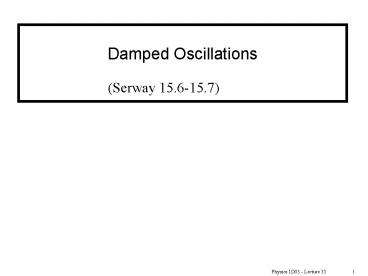Damped Oscillations - PowerPoint PPT Presentation
1 / 19
Title:
Damped Oscillations
Description:
Damped Oscillations (Serway 15.6-15.7) Example: Example: A pendulum of length 1.0 m has an initial amplitude 10 , but after a time of1000 s it is reduced to 5 . – PowerPoint PPT presentation
Number of Views:225
Avg rating:3.0/5.0
Title: Damped Oscillations
1
Damped Oscillations
(Serway 15.6-15.7)
2
Simple Pendulum
Recall, for a simple pendulum we have
the following equation of motion
L ? T
Which give us
--------------------------------------------------
-----------------------
mg
Hence
or
Application - measuring height
- finding variations in g ? underground resources
3
SHM and Damping
SHM x(t) A cos ?t Motion continues
indefinitely. Only conservative forces act, so
the mechanical energy is constant.
Damped oscillator dissipative forces (friction,
air resistance, etc.) remove energy from the
oscillator, and the amplitude decreases with time.
4
A damped oscillator has external
nonconservative force(s) acting on the system. A
common example is a force that is proportional
to the velocity.
f -bv where b is a constant damping
coefficient
Fma give
eg green water(weak damping)
For weak damping (small b), the solution is
A e-(b/2m)t
5
Without damping the angular frequency is
With damping
Effectively, the frequency ? is slower with
damping, and
the amplitude gets smaller (decays exponentially)
as time goes on
6
Example
A mass on a spring oscillates with initial
amplitude 10 cm. After 10 seconds, the amplitude
is 5 cm.
Question What is the value of b/(2m)?
Question What is the amplitude after 30 seconds?
7
Example A pendulum of length 1.0 m has an
initial amplitude 10, but after a time
of1000 s it is reduced to 5. What is b/(2m)?
8
Types of Damping
Since
water
We can have different cases for the value
under the root gt0, 0 or lt0. This leads to three
types of damping !
Eg Strong damping (b large) there is no
oscillation when
axle grease?
9
Underdamped, oscillations with decreasing
amplitude
Critically damped
Overdamped, no oscillation
x(t)
overdamped
critical damping
Critical damping provides the fastest dissipation
of energy.
t
underdamped
10
Quiz If you were designing a automobile
suspensions
- Should they be
- Underdamped
- Critically damped
- Overdamped
- I dont need suspension !
11
- Example
- Show that the time rate of change of mechanical
energy for a damped oscillator is given by - dE/dt-bv2
- and hence is always negative.
12
Damped Oscillations and Resonance
(Serway 15.6-15.7)
- Forced Oscillations
- Resonance
13
Forced Oscillations
A periodic, external force pushes on the mass (in
addition to the spring and damping)
This transfers energy into the system
The frequency w is set by the machine applying
the force. The system responds by oscillating at
the same frequency w. The amplitude can be very
large if the external driving frequency is close
to the natural frequency of the oscillator.
14
is called the natural frequency or resonant
frequency of the oscillation.
Newtons 2nd Law
Assume that x A cos (wt f) then the
amplitude of a drive oscillator is given by
15
So, as the amplitude, A,
increases ! If the external push has the
same frequency as the resonant frequency
?0. The driving force is said to be in
resonance with the system.
A
16
Resonance occurs because the driving force
changes direction at just the same rate as the
natural oscillation would reverse direction, so
the driving force reinforces the natural
oscillation on every cycle.
Quiz Where in the cycle should the driving force
be at its maximum value for maximum
average power?
- When the mass is at maximum x (displacement)
- When the mass is at the midpoint (x 0)
- It matters not
17
- Example
- A 2.0 kg object attached to a spring moves
without - friction and is driven by an external force given
by - F(3.0N)sin(8pt)
- If the force constant of the spring is 20.0N/m,
determine - the period of the motion
- the amplitude of the motion
18
(No Transcript)
19
Summary
- An oscillator driven by an external periodic
force will oscillate with an amplitude that
depends on the driving frequency. The amplitude
is large when the driving frequency is close to
the natural frequency of the oscillator. - For weak damping, the system oscillates, and the
amplitude decreases exponentially with time. - With sufficiently strong damping, the system
returns smoothly to equilibrium without
oscillation.
Problems, Chapter 1542, 43, 70(6th ed
Chapter 13)42, 70

